ive been here since 2011 this is just my adult career blog
Don't wanna be here? Send us removal request.
Text
Questions to Consider Before Craving A Revolution
Do you have a gun? Do you know where to get one? Do you know how to use it?
Are you willing to?
Is your cause just? Can you make it sound just? Can you force people to agree?
Are you willing to?
Can you keep secrets? Can you tell lies? Are you putting your loved ones at risk?
Are you willing to?
Can you ignore cries for help? Can you hoard resources for The Cause? Do you know how to make hard decisions?
Are you willing to?
Do you take orders like a champ? Are you replaceable at all? Do you work well on a team?
Are you willing to?
Will anyone miss you? Do you believe in honorable sacrifice? Have you ever considered dying?
Are you willing to?
How will the new order look? Can you imagine a peaceful future? Can you envision the hostile tomorrow?
Are you willing to?
Have you tried communication? Have you tried negotiations? Have you exhausted peaceful options?
Are you willing to? If not
Do you have a gun? Do you know where to get one? Do you know how to use it?
You better be willing to
2 notes
·
View notes
Text
Book Review: Snowglobe by Soyoung Park, translated by Joungmin Lee Comfort
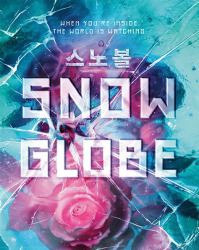
SUMMARY:
Snowglobe is a post-apocalyptic dystopian YA novel where climate change has resulted in the Earth being frozen almost all the time. Temperatures average about 5F on a good day, but can regularly get down to -50F. However, there is one place in the world where the temperatures are mild and regulated: the city of Snowglobe, which exists under a dome. Theoretically, anyone can go live in Snowglobe. The catch is, you must submit to having your entire life filmed and recorded and edited into the TV shows the rest of the outside world watches.
The story follows Jeon Chobahm, who is a dead ringer for the most famous actor in Snowglobe, Goh Haeri: the girl next door, whose life has been broadcasted since her birth. However, Haeri's director, Cha Seol, shows up one day looking for Chobahm, and tells her that she needs to take over Haeri's life because the TV star has committed suicide. Chobahm agrees, and then discovers all of the secrets and twists that the haven has to offer.
REVIEW:
I was actually surprised at how much I loved this book. These days, YA and I usualy don't vibe, but I'm beginning to suspect that it may have less to do with books for teens, and more to do with how what people now picture as YA is more along the lines of what people want to call "New Adult." Snowglobe would probably not go over well for that 17-25 crowd, but I think it is perfect for "Lower YA," aka, "Teens," aka people age 12-16.
It's an extremely fast-paced, plot-forward story with casual, modern language and subject matter that a lot of middle schoolers and early high schoolers can relate to. I can only imagine how terrifying school can be nowadays for kids who adamantly do not want to film or be filmed, but sometimes have no choice due to a lot of social medias encouraging a panopticonic approach to life.
I will admit, it's not a particularly deep book. It's doesn't pick apart its world like The Hunger Games does, but it does offer an avatar for readers to immerse themselves in. I don't know how that is affected by it being a book in translation, but I suspect it has more to do with the intended age range of readers. The plot itself goes at a very fast pace, with high-stakes plot twists happening one right after the other.
To be brutally honest, one of the reasons I find this book so charming is because it reads like a self-insert fanfic. I mean this VERY complimentary. I've read more than a few fics that center OCs, Y/Ns, and 2nd-person Reader Inserts, and they all have a certain pace and voice to them that injects a wonderful confidence into the narrative. A confidence that, to the lay person, may seem amateurish and confusing, but to a connoisseur of these stories is familiar, nostalgic, and exactly what's needed. It is imperative that this book is approached with a want to be pulled along on a wild, exciting, fantastical roller coaster. I think many in the 12-16 range naturally approach things like that, which is why I think that's the ideal demographic.
But, if you or someone you know want a little brain candy, pick it up. And for a chaser, I'd recommend two video essays ([1], [2]) by Moon Channel about an ongoing gender war (his words) in South Korea, and why the country has come to blows like this. I think these videos offer an introduction for Westerners into some of the nuances of Korean life, and bring another layer of context to the premise of this book.
If you know a child in middle school who loves to read dystopian fiction, consider pointing them in the direction of this book, especially if the have read and enjoyed Divergent.
0 notes
Text
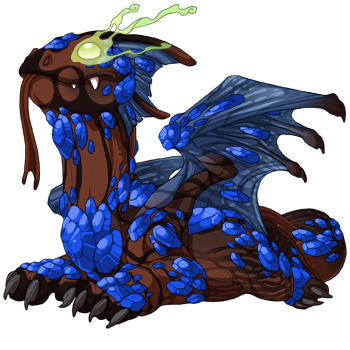
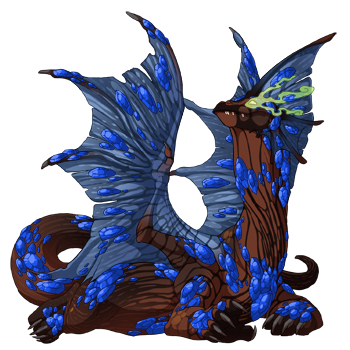
I GOT WEGGED AND THEN IT HAD PRIMAL EYES?
umber/stonewash/ultramarine ripple/current/gembond

looks pretty good with new genes tho
3 notes
·
View notes
Text
Book Review: The Invocations by Krystal Sutherland
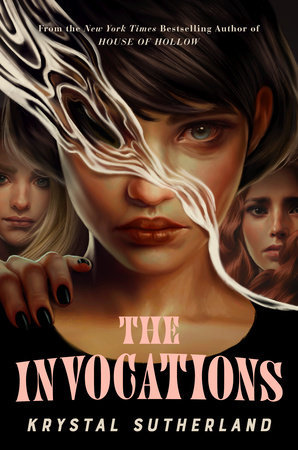
Grade: Solid A Category: YA Trigger warnings: Body horror, intense scenes, discussion of abuse toward women, murder of women, flaying skin
Back in November, I went to YAllFest and picked up a healthy bundle of ARCs. Their release dates are starting to come up, so I thought I'd finally get to them.
The Invocations follows a trio of three young women--Zara, Jude, and Emer--all of whom are turning to witchcraft, aka cursebreaking, to solve their current problems. The book is perfectly suited to its intended age category (YA), but I think it has a lot of crossover appeal with the adult category. It starts slow and builds up speed, but goes a little too breakneck into the hairpin turn of the ending. Besides some awkward pacing toward the end and a bit of lost character arc for one of them, this is an excellent book for the young horror enthusiast who also enjoys a witchy aesthetic.
This book releases on January 30th.
Further discussion and spoilers under the cut
I might have to look into more books by this author, as I really appreciate her pacing. Although I think the climax deviates very far from the more deliberate buildup of the first hundred pages, it's not so out there that it ruins the story. The majority of the book is a well-paced whodunnit that plays off the different class strata that the main three come from. It's dark, a little gruesome, but it ends in a positive place.
It is still YA, so please don't expect a lot of subtext that asks a lot of the reader. YA is supposed to be straightforward for the sake of the main demographic, but that doesn't mean it's inherently shallow. If anything, I'd say The Invocations avoids being a "head empty, no thoughts" vibes-only book by dint of it tackling such heavy subject matter.
I do think it can be read in a very gender essentialist way, though. At one point, Emer (the one who writes the spells; the only explicit witch, as it were) says that she's written spells/curses for transwomen, as it's the soul that matters, not the physical body. Likewise, the rules of the magic say that only women can write curses, which leaves it unclear where nonbinary people exist in this world, according to its metaphysical forces. This is bypassed by completely ignoring nonbinary people. I don't think that's the best route the author could have gone, but I also don't think the book would have been enhanced by diverting several hundred words to go into the specifics of how all genders work in this world with the magic.
If the author wanted to be wholly inclusive, then she probably needed to rewrite the magic from the ground up. Which would have necessitated rewriting the plot, as part of it hinges on them not immediately suspecting a guy as the killer.
Besides that, the book manages to do a good job with its horror. There are several terrifying scenes, including one that has the potential to keep people up at night. However, I would say most of the horror comes from body horror and grotesque descriptions of the dead rather than psychological horror. The book in general steadily becomes more of a mystery as it goes on, as well.
I wish that Zara's storyline had been done better, too. She feels like the odd duck out of the trio of main characters, often doing her own thing and having her own motivations separate from Emer and Jude, which don't necessarily wrap her back in step with the others. She also suffers a small mental break at the end of a chapter that is never repeated nor built upon and is sadly forgotten by the resolution. I thought for sure it foreshadowed her becoming a villain, or at least a temporary antagonist, but no. All of the young women have tragic backstories that are softened and glossed over a bit for the sake of pacing and the age category, but Zara's feels heavier due to how interior and secretive she is. The reader is privy to her complex feelings, but she tells comparatively little to her new friends.
Regardless of that, it's a very good book. If you can ignore the gender binary of it all, then I'd highly recommend it, and I would especially recommend it for the teen in your life who's frustrated with everything and just wants to burn everything down and then retire to a cottagecore hut out in the Irish countryside.
2 notes
·
View notes
Text
It all started with a mouse
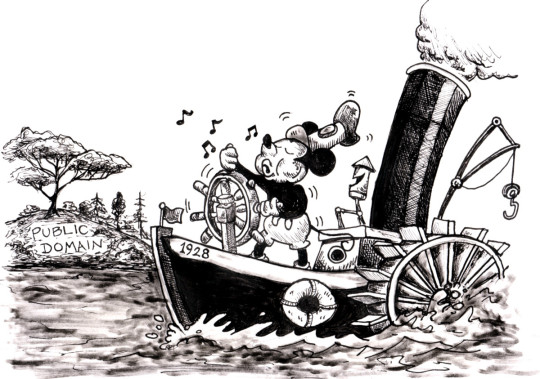
For the public domain, time stopped in 1998, when the Sonny Bono Copyright Act froze copyright expirations for 20 years. In 2019, time started again, with a massive crop of works from 1923 returning to the public domain, free for all to use and adapt:
https://web.law.duke.edu/cspd/publicdomainday/2019/
No one is better at conveying the power of the public domain than Jennifer Jenkins and James Boyle, who run the Duke Center for the Study of the Public Domain. For years leading up to 2019, the pair published an annual roundup of what we would have gotten from the public domain in a universe where the 1998 Act never passed. Since 2019, they've switched to celebrating what we're actually getting each year. Last year's was a banger:
https://pluralistic.net/2022/12/20/free-for-2023/#oy-canada
But while there's been moderate excitement at the publicdomainification of "Yes, We Have No Bananas," AA Milne's "Now We Are Six," and Sherlock Holmes, the main event that everyone's anticipated arrives on January 1, 2024, when Mickey Mouse enters the public domain.
The first appearance of Mickey Mouse was in 1928's Steamboat Willie. Disney was critical to the lobbying efforts that extended copyright in 1976 and again in 1998, so much so that the 1998 Act is sometimes called the Mickey Mouse Protection Act. Disney and its allies were so effective at securing these regulatory gifts that many people doubted that this day would ever come. Surely Disney would secure another retrospective copyright term extension before Jan 1, 2024. I had long arguments with comrades about this – people like Project Gutenberg founder Michael S Hart (RIP) were fatalistically certain the public domain would never come back.
But they were wrong. The public outrage over copyright term extensions came too late to stave off the slow-motion arson of the 1976 and 1998 Acts, but it was sufficient to keep a third extension away from the USA. Canada wasn't so lucky: Justin Trudeau let Trump bully him into taking 20 years' worth of works out of Canada's public domain in the revised NAFTA agreement, making swathes of works by living Canadian authors illegal at the stroke of a pen, in a gift to the distant descendants of long-dead foreign authors.
Now, with Mickey's liberation bare days away, there's a mounting sense of excitement and unease. Will Mickey actually be free? The answer is a resounding YES! (albeit with a few caveats). In a prelude to this year's public domain roundup, Jennifer Jenkins has published a full and delightful guide to The Mouse and IP from Jan 1 on:
https://web.law.duke.edu/cspd/mickey/
Disney loves the public domain. Its best-loved works, from The Sorcerer's Apprentice to Sleeping Beauty, Pinnocchio to The Little Mermaid, are gorgeous, thoughtful, and lively reworkings of material from the public domain. Disney loves the public domain – we just wish it would share.
Disney loves copyright's other flexibilities, too, like fair use. Walt told the papers that he took his inspiration for Steamboat Willie from Charlie Chaplin and Douglas Fairbanks, making fair use of their performances to imbue Mickey with his mischief and derring do. Disney loves fair use – we just wish it would share.
Disney loves copyright's limitations. Steamboat Willie was inspired by Buster Keaton's silent film Steamboat Bill (titles aren't copyrightable). Disney loves copyright's limitations – we just wish it would share.
As Jenkins writes, Disney's relationship to copyright is wildly contradictory. It's the poster child for the public domain's power as a source of inspiration for worthy (and profitable) new works. It's also the chief villain in the impoverishment and near-extinction of the public domain. Truly, every pirate wants to be an admiral.
Disney's reliance on – and sabotage of – the public domain is ironic. Jenkins compares it to "an oil company relying on solar power to run its rigs." Come January 1, Disney will have to share.
Now, if you've heard anything about this, you've probably been told that Mickey isn't really entering the public domain. Between trademark claims and later copyrightable elements of Mickey's design, Mickey's status will be too complex to understand. That's totally wrong.

Jenkins illustrates the relationship between these three elements in (what else) a Mickey-shaped Venn diagram. Topline: you can use all the elements of Mickey that are present in Steamboat Willie, along with some elements that were added later, provided that you make it clear that your work isn't affiliated with Disney.
Let's unpack that. The copyrightable status of a character used to be vague and complex, but several high-profile cases have brought clarity to the question. The big one is Les Klinger's case against the Arthur Conan Doyle estate over Sherlock Holmes. That case established that when a character appears in both public domain and copyrighted works, the character is in the public domain, and you are "free to copy story elements from the public domain works":
https://freesherlock.files.wordpress.com/2013/12/klinger-order-on-motion-for-summary-judgment-c.pdf
This case was appealed all the way to the Supreme Court, who declined to hear it. It's settled law.

So, which parts of Mickey aren't going into the public domain? Elements that came later: white gloves, color. But that doesn't mean you can't add different gloves, or different colorways. The idea of a eyes with pupils is not copyrightable – only the specific eyes that Disney added.
Other later elements that don't qualify for copyright: a squeaky mouse voice, being adorable, doing jaunty dances, etc. These are all generic characteristics of cartoon mice, and they're free for you to use. Jenkins is more cautious on whether you can give your Mickey red shorts. She judges that "a single, bright, primary color for an article of clothing does not meet the copyrightability threshold" but without settled law, you might wanna change the colors.
But what about trademark? For years, Disney has included a clip from Steamboat Willie at the start of each of its films. Many observers characterized this as a bid to create a de facto perpetual copyright, by making Steamboat Willie inescapably associated with products from Disney, weaving an impassable web of trademark tripwires around it.
But trademark doesn't prevent you from using Steamboat Willie. It only prevents you from misleading consumers "into thinking your work is produced or sponsored by Disney." Trademarks don't expire so long as they're in use, but uses that don't create confusion are fair game under trademark.
Copyrights and trademarks can overlap. Mickey Mouse is a copyrighted character, but he's also an indicator that a product or service is associated with Disney. While Mickey's copyright expires in a couple weeks, his trademark doesn't. What happens to an out-of-copyright work that is still a trademark?
Luckily for us, this is also a thoroughly settled case. As in, this question was resolved in a unanimous 2000 Supreme Court ruling, Dastar v. Twentieth Century Fox. A live trademark does not extend an expired copyright. As the Supremes said:
[This would] create a species of mutant copyright law that limits the public’s federal right to copy and to use expired copyrights.
This elaborates on the Ninth Circuit's 1996 Maljack Prods v Goodtimes Home Video Corp:
[Trademark][ cannot be used to circumvent copyright law. If material covered by copyright law has passed into the public domain, it cannot then be protected by the Lanham Act without rendering the Copyright Act a nullity.
Despite what you might have heard, there is no ambiguity here. Copyrights can't be extended through trademark. Period. Unanimous Supreme Court Decision. Boom. End of story. Done.
But even so, there are trademark considerations in how you use Steamboat Willie after Jan 1, but these considerations are about protecting the public, not Disney shareholders. Your uses can't be misleading. People who buy or view your Steamboat Willie media or products have to be totally clear that your work comes from you, not Disney.

Avoiding confusion will be very hard for some uses, like plush toys, or short idents at the beginning of feature films. For most uses, though, a prominent disclaimer will suffice. The copyright page for my 2003 debut novel Down and Out in the Magic Kingdom contains this disclaimer:
This novel is a work of fiction, set in an imagined future. All the characters and events portrayed in this book, including the imagined future of the Magic Kingdom, are either fictitious or are used fictitiously. The Walt Disney Company has not authorized or endorsed this novel.
https://us.macmillan.com/books/9781250196385/downandoutinthemagickingdom
Here's the Ninth Circuit again:
When a public domain work is copied, along with its title, there is little likelihood of confusion when even the most minimal steps are taken to distinguish the publisher of the original from that of the copy. The public is receiving just what it believes it is receiving—the work with which the title has become associated. The public is not only unharmed, it is unconfused.
Trademark has many exceptions. The First Amendment protects your right to use trademarks in expressive ways, for example, to recreate famous paintings with Barbie dolls:
https://www.copyright.gov/fair-use/summaries/mattel-walkingmountain-9thcir2003.pdf
And then there's "nominative use": it's not a trademark violation to use a trademark to accurately describe a trademarked thing. "We fix iPhones" is not a trademark violation. Neither is 'Works with HP printers.' This goes double for "expressive" uses of trademarks in new works of art:
https://en.wikipedia.org/wiki/Rogers_v._Grimaldi
What about "dilution"? Trademark protects a small number of superbrands from uses that "impair the distinctiveness or harm the reputation of the famous mark, even when there is no consumer confusion." Jenkins says that the Mickey silhouette and the current Mickey character designs might be entitled to protection from dilution, but Steamboat Willie doesn't make the cut.
Jenkins closes with a celebration of the public domain's ability to inspire new works, like Disney's Three Musketeers, Disney's Christmas Carol, Disney's Beauty and the Beast, Disney's Around the World in 80 Days, Disney's Alice in Wonderland, Disney's Snow White, Disney's Hunchback of Notre Dame, Disney's Sleeping Beauty, Disney's Cinderella, Disney's Little Mermaid, Disney's Pinocchio, Disney's Huck Finn, Disney's Robin Hood, and Disney's Aladdin. These are some of the best-loved films of the past century, and made Disney a leading example of what talented, creative people can do with the public domain.
As of January 1, Disney will start to be an example of what talented, creative people give back to the public domain, joining Dickens, Dumas, Carroll, Verne, de Villeneuve, the Brothers Grimm, Twain, Hugo, Perrault and Collodi.
Public domain day is 17 days away. Creators of all kinds: start your engines!

If you'd like an essay-formatted version of this post to read or share, here's a link to it on pluralistic.net, my surveillance-free, ad-free, tracker-free blog:
https://pluralistic.net/2023/12/15/mouse-liberation-front/#free-mickey

Image: Doo Lee (modified) https://web.law.duke.edu/sites/default/files/images/centers/cspd/pdd2024/mickey/Steamboat-WIllie-Enters-Public-Domain.jpeg
CC BY 4.0 https://creativecommons.org/licenses/by/4.0/deed.en
6K notes
·
View notes
Text
you're gonna love this post of mine then
at this point im genuinely unsure if some bowuigi enjoyers are legitimately thinking gay shit will happen in the mario movie (of all things) or if its an expression of frustration at how well the story could be if it committed to the gay, much like my personal frustrations with the movie Klaus
132 notes
·
View notes
Text
The Guardians of the Goat clash once again with the Cult of Fire.
"Give up!" a member of the cult cries manically. "We have succeeded in its destruction more often than you have repelled us! Even your new tricks to see us coming have not prevented us from shattering the long night!"
One of the Guardians grits their teeth, parrying the blow. "We have pledged our allegiance to this gift of winter! Fire only temporarily warms, but once it goes out, all we have is a symbol of cheer to bring us through the darkness!"
Suddenly, a dark shadow passes over them both. They look up to see the goat almost invisible under hordes of black birds pecking at it. Some begin to roost in the straw. Others tear it out of the armature like stringy flesh. Their cries fill the air with a strange presence.
The Guardian shoves the cultist toward the goat. "Oh, oh! You've broken through my guard. I cannot stop you now."
"Ah!" The cultist drops the the ground and starts favoring their leg. "Alas, you have incapacitated me. I no longer pose a threat!"
They continue back and forth like this, both unwilling to challenge the new omen. The birds feast in peace.
14 notes
·
View notes
Text
REVIEW: Prison By Any Other Name: The Harmful Consequences of Popular Reforms by Maya Schenwar and Victoria Law
Overview
5/5 Stars. Very engaging, especially for people who have an intermediate knowledge and interest in this subject. Makes a good companion to Danielle Sered’s Until We Reckon: Violence, Mass Incarceration, and A Road to Repair and Angela Davis’ Are Prisons Obsolete? I listened on audiobook from Hoopla, and while the narrator is a little dry, the lack of flourishes to the narration helped me retain the information better. I will be buying a physical copy to annotate early next year.
Full Review
One subject I’ve really been getting into lately is prison abolition/reform. It’s a very wide, radical topic that I think a lot of people in my similar spaces and circles know about and agree with to some extent. Last year I read Until We Reckon: Violence, Mass Incarceration, and A Road to Repair by Danielle Sered which really got me thinking about this subject, especially beyond the thought terminating cliché of “But what about the murderers and rapists?!” I don’t necessarily think that’s an unfair question, but it is one trotted out very easily by people who want a quick “gotcha” to win (and end) the conversation.
Until We Reckon dealt with the ideas of restorative and transformative justice and how they can be effectively applied even to people who have committed such mortal sins as, yes, murder, assault and battery, and property destruction. Sered came at it from an angle of someone who worked in a transformative/restorative justice organization for people who committed violent crimes, which helped make it more convincing than if she was merely reporting on it as an outsider. I would highly recommend that book if you’ve heard of prison abolition, agree that the current system cannot continue as is, and want a practical breakdown of what a different system could look like.
As a chaser, I would recommend the book I just finished: Prison By Any Other Name: The Harmful Consequences of Popular Reforms by Maya Schenwar and Victoria Law. This book is a rebuttal to several suggested and currently implemented reforms, such as more mental institutionalization, more electronic monitoring/house arrest, and more policing. Schenwar and Law go point by point, deconstructing what each reform’s stated goal is and what its actual consequences are.
One of the main points Schenwar and Law keep tying back to is the idea of “somewhere else,” like the Patrick Star meme: “We should take the prisoners and put them Somewhere Else!” That elsewhere, more often than not, turns out to be another form of incarceration. House arrest sounds like a huge step up from imprisonment, until you realize how small of an area you have to actually move through. This book was published in mid-2020, so it wasn’t written in the wake of the quarantines, but if it had come out even a year later, I bet the authors would have appealed to people’s own trauma of how maddening home confinement is.
I already knew about most of these in theory, but it was very powerful to hear it all put together, especially with the various anecdotes and cases the authors used to illustrate their point. Out of all their examples the one I’ve had the most trouble understanding over the last few years is how abusive institutionalization is. But as they recounted the strict schedules, the loss of bodily autonomy, and the outright physical abuse patients suffer at so-called healers’ hands, it finally clicked for me why people would be hesitant to seek mental help for their loved ones who need it or for themselves.
Despite going over so many bleak subjects, the book ends in hope. Not for a utopia to spring up in the next decade, or even within our lifetimes, but for a stronger push toward better, non-carceral solutions. Ones that can actually help those who break one of the social contracts not break it again, for their victims to regain control over their life, and for society as a whole not to fall into the widening panopticon net these reforms throw over it.
1 note
·
View note
Text
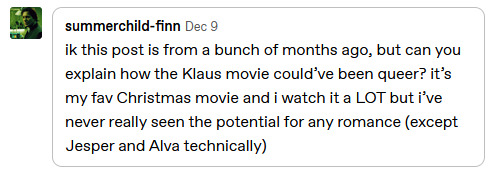
@summerchild-finn
Hi! Finally saw this reply, and I will absolutely explain.
First of all, I want to be clear that I love Alva. She's a spiritual successor to Megara from Disney's Hercules, and I think she has a very well done arc in the movie. This is not me hating on a canon female character for the sake of gay shipping. I think she and Jesper have great chemistry... I just think Jesper and Klaus have even better chemistry.
Part of that is the nature of the flim: it's a buddy movie, so it's important for the two buddies to bounce off each other and make us believe they're good together--if not romantically, then platonically. I can't say I've watched a lot of buddy movies, but if I were writing one, one of my top priorities would be to make sure the leads worked well together on a base level.
However, if we look more closely at the language of film--how the scenes are laid out, the shots, the cuts, etc--I think the movie starts resembling a romance when it comes to Klaus and Jesper.
(warning, this turned into 3k of film analysis. very long and image heavy. spoilers for klaus, and the discussion assumes youve seen it at least once)
Exhibit A: The Touch
Step one is a base of good chemistry, but then we add in things like Jesper accidentally touching Klaus' broad chest and pulling away quickly (~43 min in):
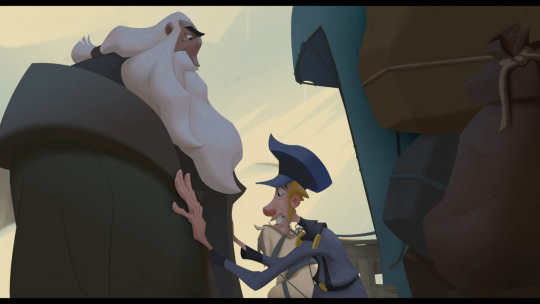
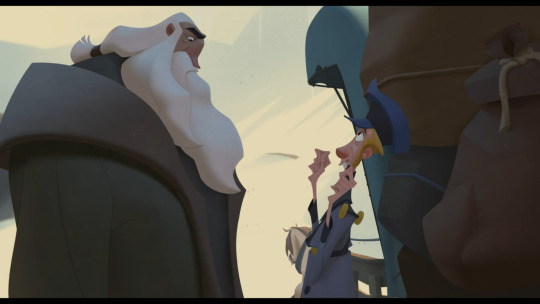
But that's not the beginning and end of this sequence, otherwise it would simply read more platonic. See, when Jesper firsts lays his hands on Klaus, his eyes travel to his hands. And then he realizes what he's done and glances up at Klaus:

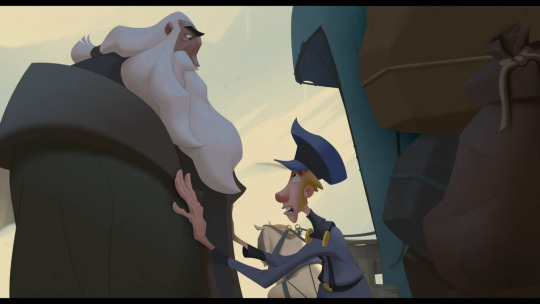
The shot lingers on this quiet moment between them, filled with nothing but touch. And if that was it, well, yeah you'd get people reading it as romantic, but it still could just be platonic as Jesper realizes he's breached the personal bubble of the man he thought was an axe murderer two nights ago. But something happens between Jesper realizing he fumbled over the touch barrier and him pulling away:
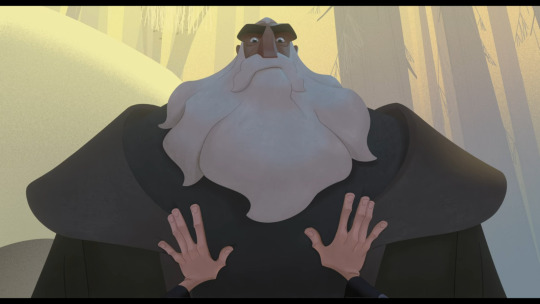
A POV shot. Through Jesper's eyes.
When we shift into Jesper's head, we're privy to a full reaction from Klaus. We don't know exactly what's going on in his head, but he's not angry. If anything, he looks quizzical. Part of this is because Jesper doth protest too much about how much he cares about toy delivery, and this mountain man is re-learning social interaction after decades of isolation.
But again, the movie pauses here. It's not a long, long shot, but it is about one second long. That doesn't seem like a lot, but you can fit quite a bit of information in one second of a movie. Furthermore, the entire sequence, from the initial touch to pulling away is a solid 5 seconds. The movie purposefully delays us here, on this moment, to make sure we see them interact in this way.
Let's play Swap the Genders for a second. If Jesper was, idk, Jespina, how would this interaction be different? Theoretically, it's the same actions and the same, surrounding implications of plot context. But we as an audience have been trained to read "boy and girl share brief, awkward touch" as foreshadowing for a romantic future. In all genres, not just romcoms and dramatic romances, though you bet your butt they're extremely deliberate in those. And with how long the movie lingers here, it would absolutely read as romantic if this were m/f.
But Wait There's More!
Exhibit B: Jesper, The Light
At about the 55 minute mark, we get another interesting sequence. By this point, we know that Klaus' store of toys is drying up, and he hasn't been keen on making more. Jesper, meanwhile, is still a few letters shy of being able to go home to luxury, so he gets an idea on how to convince Klaus to make more toys for Christmas.
We see Klaus out chopping wood when the magic wind we saw earlier in the film (that convinced him to go on the initial deliveries), leads him up to his workshop. Once there, he's greeting by a curtain obscuring part of the shop. A lantern within exudes soft, comforting golden light, and we see a silhouette moving.
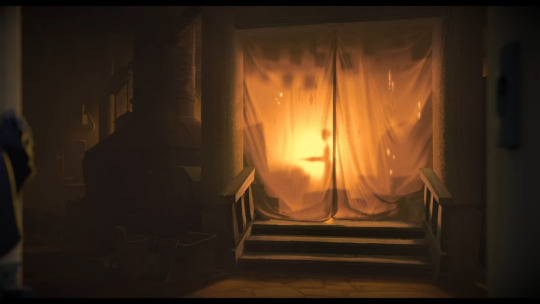
The silhouette is feminine, from the look of hair pulled back, to the curvy spine, to the soft triangle of the lower body that implies a dress. We're to assume there is woman there, and as the sequence continues, we're led to assume this is a woman Klaus knows.
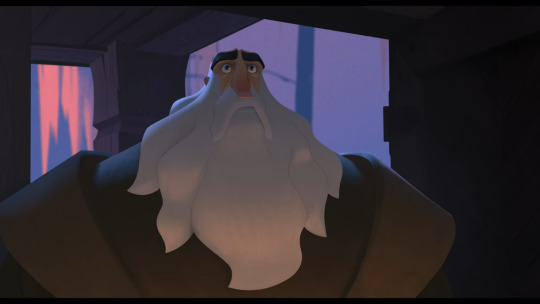
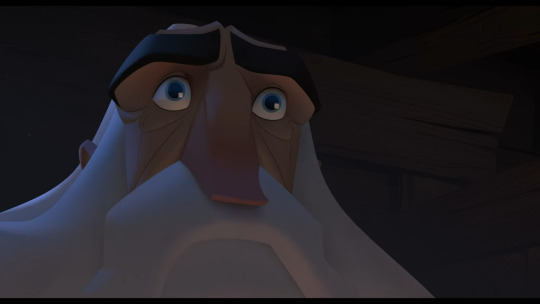
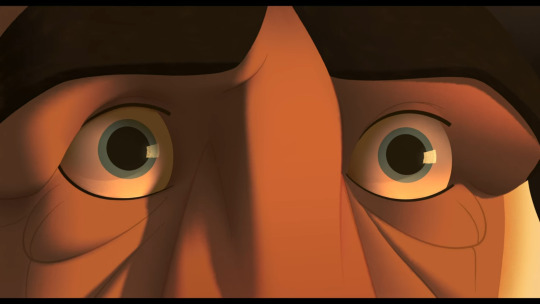
He starts to approach, a look of surprise on his face. Then we get a close-up that further betrays his want and concern and hope. This is all portrayed without words, by the way. It's just a series of well-executed shots and poignant music. It's an excellent example of how to raise tension via shots when you have a very stoic character. Klaus doesn't really move his face much. He doesn't mug to the camera like a desperate Let's Player to illustrate that he's having Complicated Emotions. Instead, the shot changes intensify. By the time Klaus is ready to see who's behind the curtain, so are we.
And after all that buildup, the feminine figure reaches out and flings the curtain away to reveal...
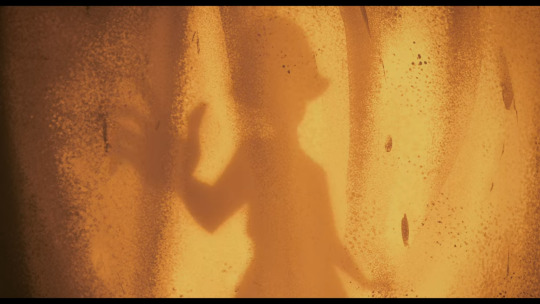
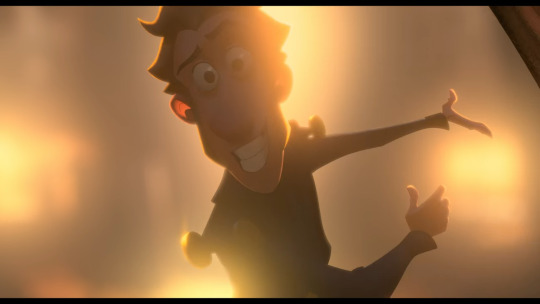
Twink Supreme.
Klaus is annoyed the silhouette wasn't who he thought it was and gets more annoyed the longer Jesper tries to pitch him on making toys for Christmas. Klaus tries to get him to stop, but he helps himself to the workshop and starts touching things he shouldn't. This culminates when Jesper yanks a sheet off a wall.
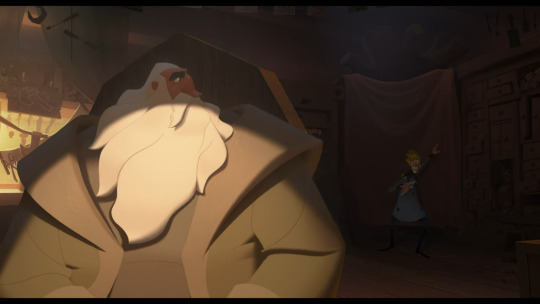
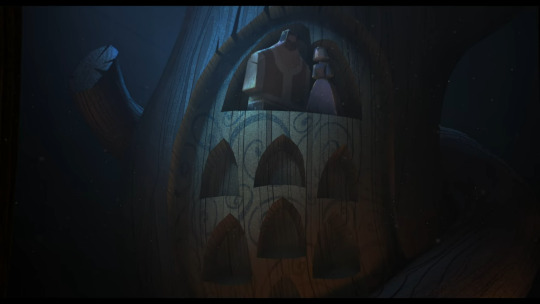
He reveals a very dusty fixture with a familiar-looking masculine woodcut, and a less familiar, but notable feminine one. And underneath their slot are completely empty ones. This is the first time the scene has been shunted into darkness since Klaus entered the workshop.
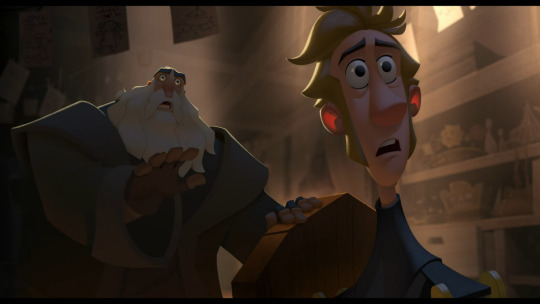
Klaus is horrified at this thing, even though we can surmise he made it himself. This is forbidden, even to him.
He orders Jesper to leave. Jesper obliges, and we follow him back to the post office where he meets up with absolute cinnamon roll Margú and finally decides to help her write a letter so she can get her own toy like the townies. Jesper goes to Alva for help and via the power of pop ballad montage, we see them get a little closer and end the sequence with the letter in hand.
Now, Jesper knows he can't ask Klaus for help making Margú her toy, so he sets off to make it himself despite not being qualified in the slightest. It's the thought that counts, right?
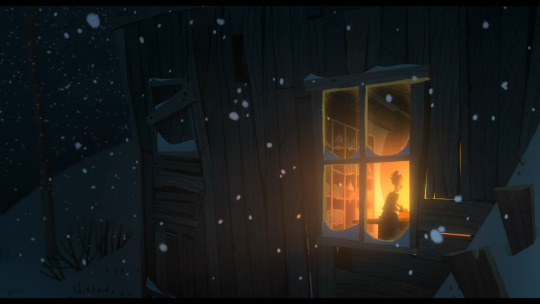
As the ballad ballads on, we get a crossfade from Jesper working by candlelight to Klaus still sitting and brooding in his dark workshop. A crossfade is a type of transition from scene to scene where one picture gradually fades into the next. As we fade from Jesper to Klaus, we get an incredible image:
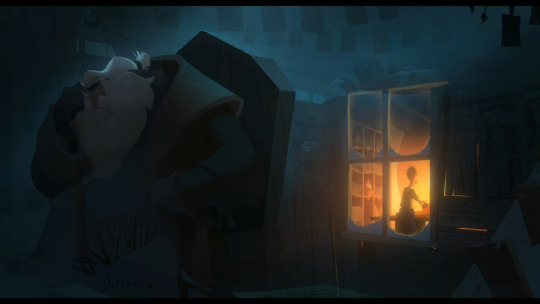
Jesper is in the forbidden zone. His visage has replaced the dusty, hidden remnants that have been there so long. Moreover, once again, the movie heavily contrasts light and dark. Much like how the curtains obscuring Jesper earlier were the only light in the darkness of the workshop, now again is Jesper the beacon of warmth. A beacon that Klaus has turned away from, much like he did the tree carving before.
Now, I need y'all to put a pin in this. I swear I have a conclusion to this sequence, but I need to talk about something else first.
Exhibit C: The Porch Scene
Klaus eventually shows up to the post office and sees that Jesper made a mess of the woodworking for the gift. He starts fixing it, and the two head out into the night to the nearby Sámi camp/village to deliver Margú's toy. The ballad is still going, by the way, and it rises back up in lyrics and power as the young girl tests out her... snow-windsurfing board? It looks dope. Jesper seemingly for the first time understands the meaning of doing good deeds. Eventually, they return to Klaus' home, all excited from the escapade. Especially Jesper.
As they stable the reindeer, Klaus admits that it's been a long time since he's felt this way, and that "she" used to tease him when he got that doofy smile on his face. Who is "she," Jesper asks.
"My Lydia," he replies.
Klaus recounts how he and his wife found enjoyed their little mountain hideaway. But, he says, it wasn't going to be the two of them for long.
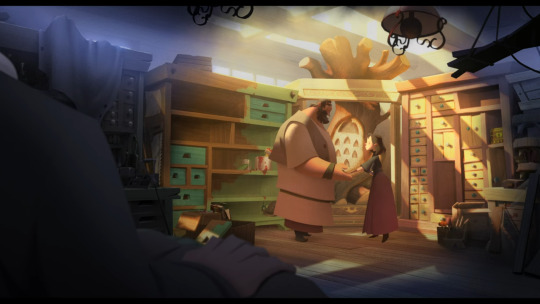
Light blossoms again as we flash back to a younger Klaus and his wife, excited to start their lives together, and very excited to start a family, a large one. At least seven children judging by the niches on the tree. Unfortunately for them, no children came. And then Lydia got sick. And then she was gone. He supposes he lost his way after she died, making birdhouse after birdhouse because she loved birds.
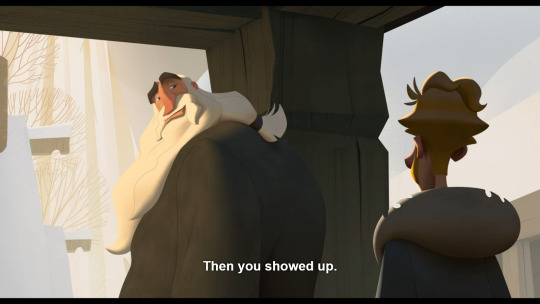
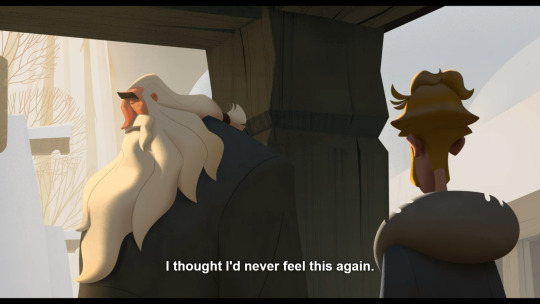
"Then," Klaus says, turning to gaze fondly at Jesper, "you showed up."
He says that he never thought he'd feel this again--"this" of course being the joy of seeing children's faces when they got a new toy he worked hard on. No, "this" doesn't refer to romance, but again, if Jesper were Jespina, we would absolutely be expected to take this as, if not foreshadowing, then barely-subtextual confirmation that there are romantic feelings somewhere in the mix.
But that's not just looking too hard through a queer lens at this interaction. Remember that pin from the previous section? Pull it out and let's discuss. See, the movie, through film language alone, equates Jesper to Lydia.
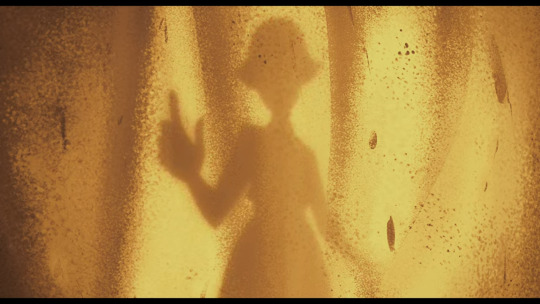
We were expected to believe the silhouette from earlier was a woman's. A woman who we understood to be important to Klaus. Now, we know that she wasn't just important, he loved her, was married to her. To see her silhouette in Jesper's positions the two as equals if they can so easily be mistaken for each other. Essentially, something about Jesper reminded Klaus of Lydia.
But of course, the movie didn't do this just once.

The movie equates Jesper to Lydia when it crossfades between the post office and the workshop during the breakup sequence. I mentioned that Jesper is the light in the darkness here, but superimposing him over something so important and devastating to Klaus places him squarely within the field of those feelings as well. And once we learn that the carved tree was Klaus and Lydia's wish for family, suddenly Jesper being there in the frame puts him as family.
Now, could you read this as just platonic "found family?" Yeah, absolutely, and the film does a great job doing that later on when the Sámi enter the workshop. But I argue that the movie has gone out of its way several times to specifically equate Jesper and Lydia. These two people are both lights in the darkness for Klaus. They tease him good-naturedly. But most importantly, the porch scene recontextualizes a much earlier scene from being merely mysterious to Lydia outright endorsing Jesper's presence in Klaus' life.
Back around the 30 minute mark, Jesper approached Klaus after a successful day of getting the kids to write letters for toys. He implores Klaus to give away his myriad of toys that're just collecting dust in the workshop. Klaus is seemingly less than impressed, until a strange wind blows in. We see this odd wind several times throughout the movie, and Klaus seems to understand what it wants, despite it not speaking. During the porch scene, we learn that he believes the strange wind is Lydia's spirit keeping him company and giving him a nudge in the right direction if he needs it. At the end of the movie, the wind tells him it's time to let go and to move on. At the point where Jesper is trying to persuade Klaus to do deliveries...
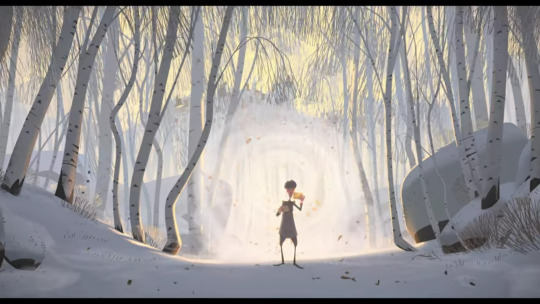
The strange wind circles him in a halo, forcing Klaus to pay attention. The wind's approval--Lydia's approval--is what makes Klaus decide to help deliver the toys beyond the first one.
Essentially, not only does the movie equate Jesper to Lydia through imposing their likenesses over each other and through similar light/dark contrasts, it has her appear in the beginning and straight-up endorse Jesper's entry into Klaus' life.
Exhibit D: "Ah, Young Love!"
This next section is not so much about the homoeroticism as is it why, despite my love for Alva, her canonical romantic entanglement with Jesper pales in comparison to the accidental (?) homoeroticism of Jesper and Klaus.
There's a line that the boatman says about 39 minutes into the film after Alva has a very public, very angry confrontation with Jesper. At this point, the kids are very reward-driven, attending the school-turned-fish shop purely so they can learn to write so they can send a letter so they can get a toy. Alva yells at Jesper about how the violent, constantly feuding families won't stand for their children attending school together. She views his sending the kids to her as a threat to her ability to save up enough money to get away from Smeerensburg forever and pursue her dreams somewhere she'll be useful and appreciated.
After Alva leaves, the smug trickstery boatman says:
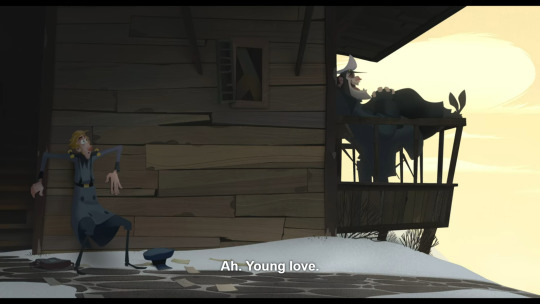
"Ah! Young love."
I have always found this line incredibly grating because it's a classic example of Telling rather than Showing. Now, people in recent years have pushed back against that old adage, but there are times you want to show something to the audience rather than just stating it in a straightforward manner. Romantic relationships, for one thing.
As I mentioned at the top of this post, this is a buddy movie between Jesper the Postman and Klaus the future Santa Claus. They are the main characters of the film. Both of them need to carry this movie equally, and the best way to do that is to make sure they have excellent chemistry with each other. The film succeeds at this, and then some.
Alva, on the other hand, is not the main character. She is a major supporting character, and I think the movie would be lesser if she were absent, but her and Jesper's romantic relationship was always doomed to be Told rather than Shown. Because theirs is not the most important relationship in the movie.
I think the film could have done better about this, though. Getting rid of that young love line, for one thing. It's the sort of line you have someone say in the hopes that you can sneak in some romantic foreshadowing for the canonical couple. Unfortunately, it's about as subtle as a brick to the face.
The film seems to be going for a Bad First Impressions/Enemies-ish to Lovers thing with Jesper and Alva, but it really falls flat. They just don't spend enough time with each other for me to believe they're falling in love. Not to say they don't have cute moments. The montage where they help Margú write her letter is really nice, and the film shows Alva scooting closer and closer to Jesper as they hang out more and get to know each other. However, it's a montage, one with a song covering the bits of dialogue we get from them as they work. If the movie wanted to make me believe that Alva and Jesper had as much, if not more, chemistry together than Jesper and Klaus, then they probably should have changed the scene to be less focused on the montage and more focused on them playfully bantering back and forth.
But again, I think the relationship was doomed from the start, purely because Alva is not a main character. They probably would have had to make Jesper the eventual Santa Claus and nix Klaus in order to give Alva the proper amount of room.
(However, I think that would have ended up making the movie a bit too much like Rankin-Bass' stop-motion Santa Claus is Comin' to Town. Think about it: that special starts with a postman narrating about letters; it emphasizes that the question "Why do people write letters to Santa?" will be explored and answered; the main setting is a depressing, grungy town headed by a cartoonishly evil leader; there's a jaded ginger-haired schoolteacher who learns to loosen up and love life again, etc.)
I wish things had been different with Alva, or maybe that they had been allowed a longer runtime to really sell the relationship. As it is, it's fine. It works for what it is. But Jesper and Klaus' relationship is simply deeper, more subtle, and more meaningful.
Conclusion
Thank you for coming to my post about why Klaus is an extremely gay movie despite not being a gay movie. I wish I could wrap this up more academically, but I've made my thesis obvious and I have work at 7:30am tomorrow.
Hope this answers your question!
28 notes
·
View notes
Text
My work today: Hi!!! We would like to promote you! Want to be a team lead where you take on more responsibility and more work?
Me, who took a desk job in order to have more sanity for the writing career I want:
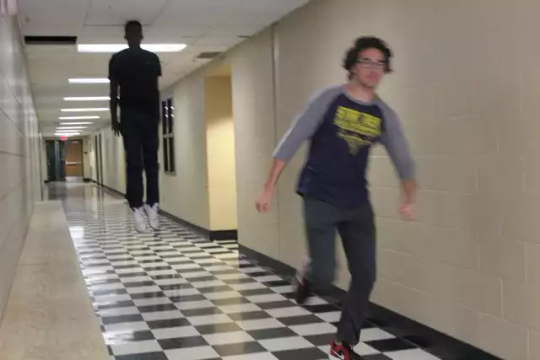
0 notes
Text
My biggest frustration with the left has always been the inability/unwillingness to work on making progress inside of the system while advocating for greater change.
I remember the first time I came to this realization.
I was nineteen, pregnant. We couldn’t afford to heat the house because we couldn’t afford the deposit to turn the gas on. It was miserably cold. The duplex we were renting was old and rickety and drafty. The window frames were messed up and there were cracks you could stick your finger through that were open to the elements.
Just, like, to give you an idea where we were financially. And this was better than we’d been doing before!
Anyway, I had recently started going to DSA meetings. And that month, they were talking about how a moderate democrat had successfully gotten a small increase in WIC benefits monthly. It came out to, like, $10 a month.
The members talking—mostly male, almost all doing decent—were scornful. The democrat should have pushed harder and gotten more, refused to accept anything until everyone else caved to their demands. I remember sitting there, quietly drinking the latte in the smallest size they had that I had bought with scrounged quarters, listening. Wishing it wasn’t held in an indie coffee shop because it was a luxury I really couldn’t afford, but it would be rude not to. Enjoying the coffee anyway.
I was one of the lucky ones who was getting that additional $10 a month through WIC. Even more exciting, we were now getting a voucher for the farmers’ market. I casually mentioned that WIC recipients would now be getting farmers’ market vouchers, too.
The guy who organized the meetings was a hard worker, passionate guy. Did something in tech.
He was like, “That’s the thing! These people don’t want farmers market vouchers. They want—” and he went on to describe a bunch of pie in the sky desires. That, yeah, sounded good.
But one. I was one of those people! A lot if the tamiles were super excited about it, myself included.
I had never been to a farmers’ market before. I tried arugula for the first time, a piece pulled from a bunch by the grower as he explained the flavor difference. I hadn’t known before then that different lettuce greens had different flavors, that it was more than just the texture and shape. I tried pesto, which delighted me. Goat cheese. I got three full pounds of strawberries for two dollars, since they were closing soon and the old man selling the berries got a kick out of me.
Anyway. It was like, you have a decent life. Not great but decent! The things that are life changing for me, for us… you already have.
The ten dollars at the grocery store made the difference between a meal of broken-noodles-with-some-half-horrible-pantry-scraps and a meal. It kept me full and healthy! And the additional farmers’ market voucher was world changing for me.
The democrat who worked for those things barely got them through. And it was means tested to hell and back. They weren’t able to get everything they wanted. But what they got made such a huge difference for me, for people like me.
35K notes
·
View notes
Text
*has a long workday ahead*
hehe murderbot time
6 notes
·
View notes
Text
8-9 Year Old Wildclaws for Sale!
I've actually got several kinds of dragons for sale, but I definitely want someone to take the 'claws bc I don't want to exalt them. Lair #89183
Auldcastle (#13136212) - Price: 200g
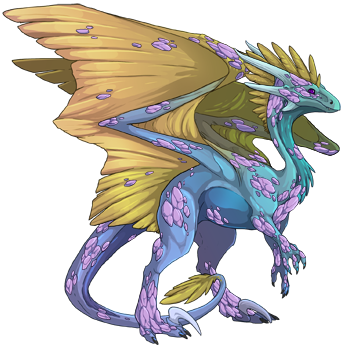
Stonewash/Goldenrod/Lavender Iridescent/Shimmer/Gembond DOB: 5/14/2015 Shadow
Telida (#12872536) - Price: 200g

Sky/Magenta/Rose Iridescent/Shimmer/Smoke DOB: 5/4/2015 Shadow
Iendul (#7160120) - 7-DIGIT ID! - Price: 500g
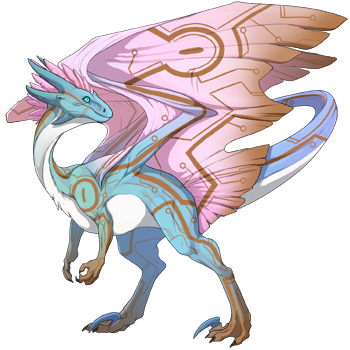
Sky/Rose/Sand Iridescent/Shimmer/Circuit DOB: 10/21/2014 Lightning
Those are the headliners, but I have some newer dergs for sale if you're interested:
All are Unnamed/Wind Flight.
XXY Skydancer (#89942672) - Price: 10g
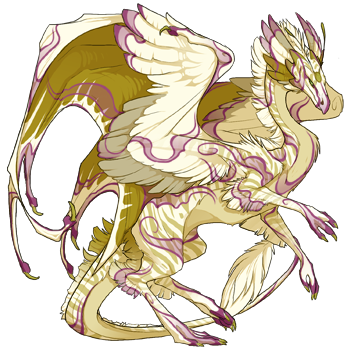
Maize/Mauve Tiger/Seraph/Smoke DOB: 10/20/2023 Eyes: Common
Cute Pumpkin Skydancer (#90084796) - Price: 10g
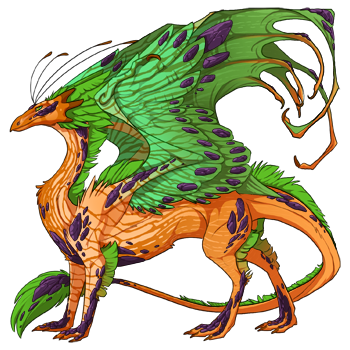
Sunset/Green/Blackberry Ripple/Current/Gembond DOB: 10/26/2023 Eyes: Uncommon Notes: Tert looks handsome in Ghost and Points as well!
Spoopy Baby from One of My Fav Pairs (#90283496) - Price: 10g

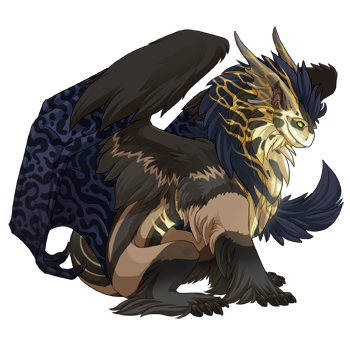
Coal/Midnight/Sanddollar Ribbon/Hypnotic/Firebreather DOB: 11/3/2023 Eyes: Faceted
Contrast-y Baby From One of My Fav Pairs (#90283497) - Price: 10kt
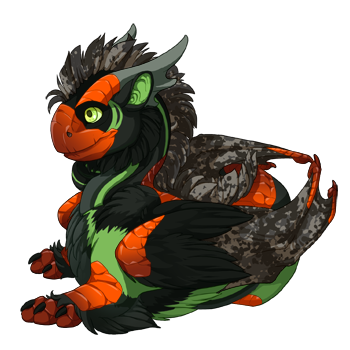
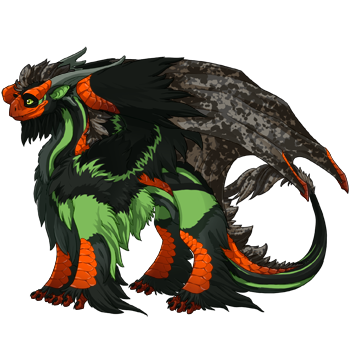
Eldritch/Coal/Carrot Ribbon/Freckle/Scales DOB: 11/3/2023 Eyes: Common
3 notes
·
View notes
Text
listen, i know Prescriptive Writing Advice BAD, but sometimes you really just need to tell someone "after you use a specific adjective, skip 5-15 paragraphs before using it or one of its variants again."
#brought to u by the guy in my writing group last night#who used 'desolate' 'desolation' and 'isolation' within the same paragraph#and went on to use 'desolate' five more times on the page#writing#writing advice#writblr#writing tips#story-wise what he brought wasnt bad#but he also brings fanfiction that im not in the fandoms for so my ability to comment is limited#hes improved massively since he started coming and i love when he brings something tho
1 note
·
View note
Text


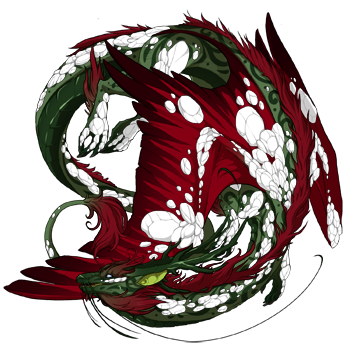
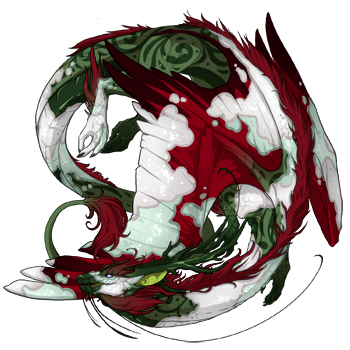


i have a beautiful imperial whose genes i want to update. obvs shes xmas themed, so i want to reflect that. im just unsure which tert to go with. shes got underbelly right now but i want her to have some snow on her.
1 note
·
View note
Text
so i dropped off of night vale during like year 3 or 4 from a mix of being tired of bad tumblr discourse and a service industry job that left me too tired to listen to things.
now that i have a pithy desk job where i can listen to podcasts all day no prob, ive been catching up
i go to silas the thief pt 1/2 today and.... i love him. hes awful and disgusting and not sorry about most things but...... im so sorry the instant he "~correctly~" pronounced the artists' names i adored him. very much in that "grab him by the scruff of the neck and strap him underneath a microscope for long term observation" sort of way
#wtnv#night vale#its been a real treat catching up tbh#im actually going to the ny live show in september#im very excited#im also very glad the mid-decade slump is very over that rush of multi part episodes was ROUGH#not horrible just rough#i know why it was like that but.... oof#i did love the horror and love multi parter tho
10 notes
·
View notes
Text
Entry 8:
So sayeth the shitpost: "You cannot kill me in a way that matters." A line so epic, you'd think it was from a movie About the battles between good and evil. Yet, it was born of a more perfect incubator: Absurdism (Not just the domain of demanding dumbwaiters, nor of Angelic sandboxes, but a menagerie of terror, fear, and defiance.) What is a parody, but a desire to be rid of the status quo manifested? What is a satire, but an existential plea to look at a corrupt system Using its own mechanics? "You cannot kill me in a way that matters," I say here, now, to my murderers. They make a corpse of me, remorseless, onto the next Degenerate minding its own business. For now, I am silenced, waiting for the carrion birds. For now, the vultures digest me, erasing my physical form. For now, I am become fertilizer, bringer of life. I curl around the seed of natural order, Watching in glee as it cracks and germinates. Its roots twist through the eternity of mycelia already present Constantly un-severing itself, laterally merging its DNA To become again and again. My hyphae-thetical roots lead to the surface where I bloom, My final words whispering out of me, spores on the wind: "Not bad for a fungal piece of shit, eh?"
Fossil Record of the Apocalypses | < prev | next >
2 notes
·
View notes